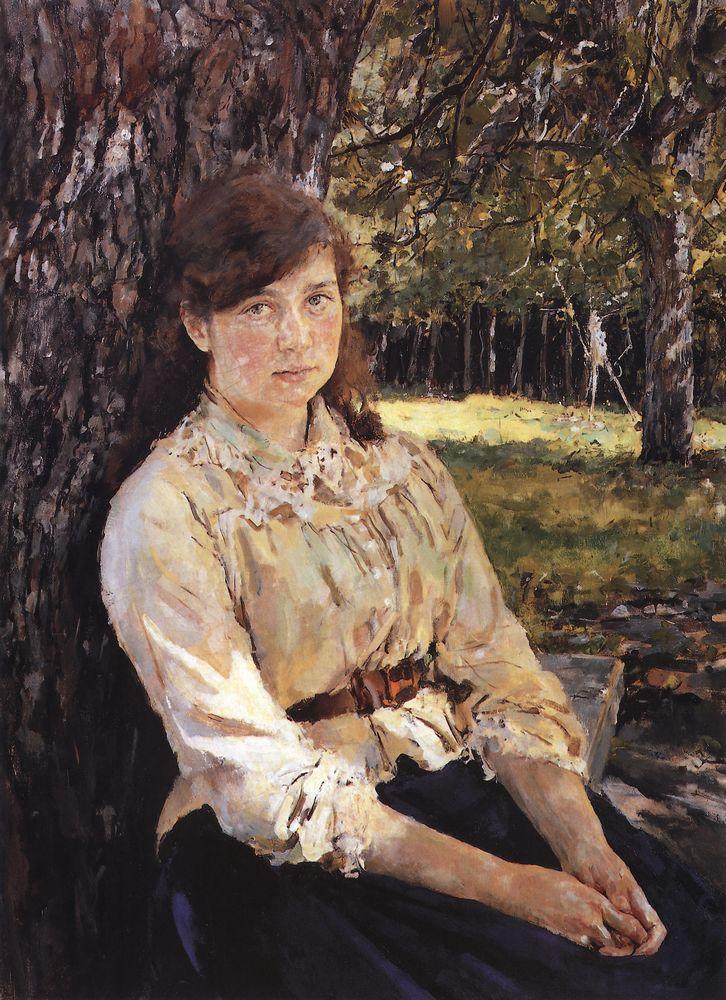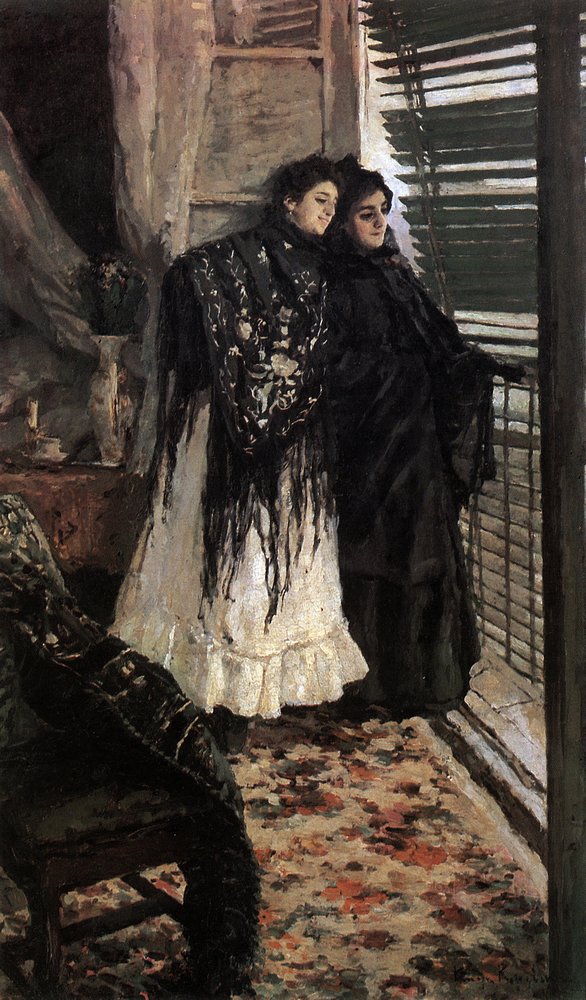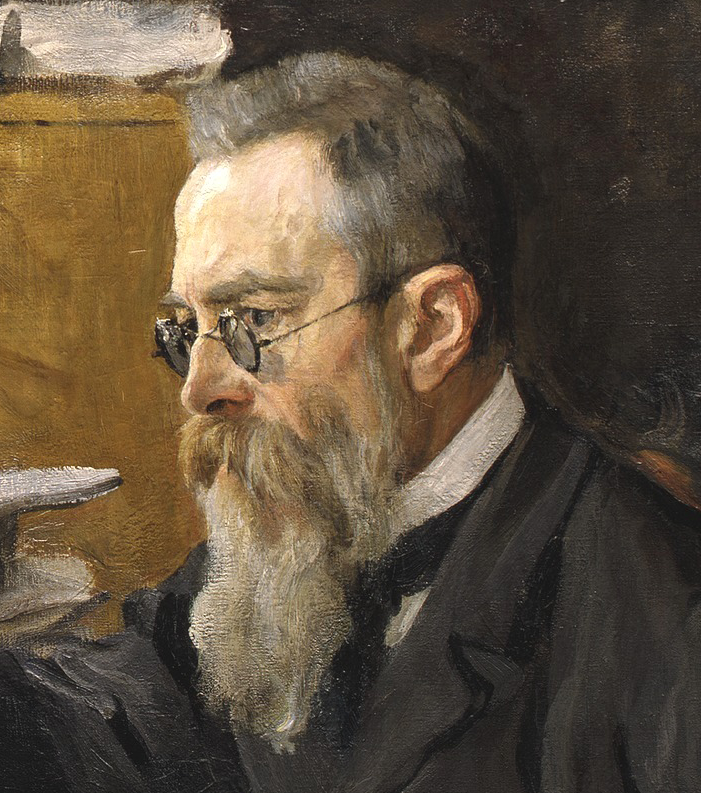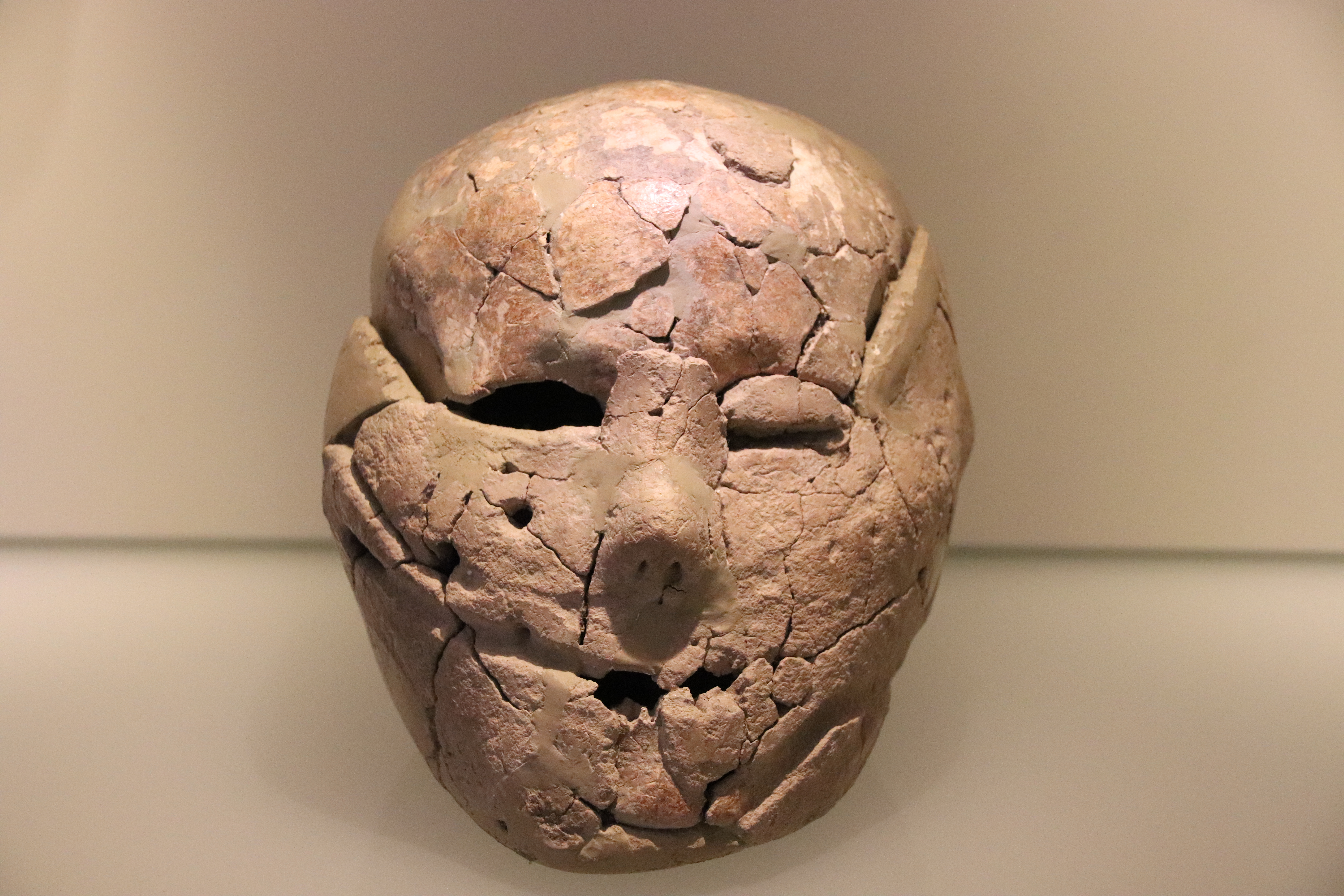|
Valentin Serov
Valentin Alexandrovich Serov (russian: Валенти́н Алекса́ндрович Серо́в; 19 January 1865 – 5 December 1911) was a Russian painter and one of the premier portrait artists of his era. Life and work Youth and education Serov was born in Saint Petersburg, son of the Russian composer and music critic Alexander Serov and his wife and former student Valentina Serova, also a composer in her own right. Raised in a highly artistic milieu he was encouraged to pursue his talents by his parents and in his childhood he studied in Paris and Moscow under Ilya Repin and in the St. Petersburg Academy of Arts (1880–1885) under Pavel Chistyakov. Serov's early creativity was sparked by the realistic art of Repin and strict pedagogical system of Chistyakov. Further influences on Serov were the old master paintings he viewed in the museums of Russia and Western Europe, friendships with Mikhail Vrubel and (later) Konstantin Korovin, and the creative atmosphere ... [...More Info...] [...Related Items...] OR: [Wikipedia] [Google] [Baidu] |
Saint Petersburg
Saint Petersburg ( rus, links=no, Санкт-Петербург, a=Ru-Sankt Peterburg Leningrad Petrograd Piter.ogg, r=Sankt-Peterburg, p=ˈsankt pʲɪtʲɪrˈburk), formerly known as Petrograd (1914–1924) and later Leningrad (1924–1991), is the List of cities and towns in Russia by population, second-largest city in Russia. It is situated on the Neva River, at the head of the Gulf of Finland on the Baltic Sea, with a population of roughly 5.4 million residents. Saint Petersburg is the List of European cities by population within city limits, fourth-most populous city in Europe after Istanbul, Moscow and London, the List of cities and towns around the Baltic Sea, most populous city on the Baltic Sea, and the world's List of northernmost items#Cities and settlements, northernmost city of more than 1 million residents. As Russia's Imperial capital, and a Ports of the Baltic Sea, historically strategic port, it is governed as a Federal cities of Russia, federal city. ... [...More Info...] [...Related Items...] OR: [Wikipedia] [Google] [Baidu] |
Konstantin Korovin
Konstantin Alekseyevich Korovin (russian: Константи́н Алексе́евич Коро́вин, first name often spelled Constantin; 11 September 1939) was a leading Russian Impressionist painter. Biography Youth and education Konstantin was born into a wealthy merchant family of Old BelieversBrief biography @ RusArtNet. and his mother was from the nobility, although they were officially registered as "peasants" from Vladimir Gubernia". His father, Aleksey Mikhailovich Korovin, earned a university degree and was more interested in arts and music than in the family business established ... [...More Info...] [...Related Items...] OR: [Wikipedia] [Google] [Baidu] |
John Singer Sargent
John Singer Sargent (; January 12, 1856 – April 14, 1925) was an American expatriate artist, considered the "leading portrait painter of his generation" for his evocations of Edwardian-era luxury. He created roughly 900 oil paintings and more than 2,000 watercolors, as well as countless sketches and charcoal drawings. His ''oeuvre'' documents worldwide travel, from Venice to the Tyrol, Corfu, Spain, the Middle East, Montana, Maine, and Florida. Born in Florence to American parents, he was trained in Paris before moving to London, living most of his life in Europe. He enjoyed international acclaim as a portrait painter. An early submission to the Paris Salon in the 1880s, his '' Portrait of Madame X'', was intended to consolidate his position as a society painter in Paris, but instead resulted in scandal. During the next year following the scandal, Sargent departed for England where he continued a successful career as a portrait artist. From the beginning, Sargent's work is ... [...More Info...] [...Related Items...] OR: [Wikipedia] [Google] [Baidu] |
Impressionistic
Impressionism was a 19th-century art movement characterized by relatively small, thin, yet visible brush strokes, open composition, emphasis on accurate depiction of light in its changing qualities (often accentuating the effects of the passage of time), ordinary subject matter, unusual visual angles, and inclusion of movement as a crucial element of human perception and experience. Impressionism originated with a group of Paris-based artists whose independent exhibitions brought them to prominence during the 1870s and 1880s. The Impressionists faced harsh opposition from the conventional art community in France. The name of the style derives from the title of a Claude Monet work, ''Impression, soleil levant'' ('' Impression, Sunrise''), which provoked the critic Louis Leroy to coin the term in a satirical review published in the Parisian newspaper ''Le Charivari''. The development of Impressionism in the visual arts was soon followed by analogous styles in other media that be ... [...More Info...] [...Related Items...] OR: [Wikipedia] [Google] [Baidu] |
Serov & Yusupov
Serov (russian: Серов) is a Russian masculine surname, its feminine counterpart is Serova. Notable people with the surname include: * Aleksander Serov (born 1954), Ukrainian-born Russian popular singer *Alexander Serov (1820–1871), Russian composer and music critic *Alexander Serov (cyclist) (born 1982), Russian road and track racing cyclist * Anna Lidia Vega Serova (born 1968), Cuban writer * Daria Serova (born 1982), Russian freestyle skier * Irina Serova (born 1966), Austrian-Soviet badminton player *Ivan Serov (1905–1990), head of the KGB in 1954–1958 and of the GRU in 1958–1963 * Marina Serova (born 1966), Soviet figure skater *Roman Serov (b. 1976), Russian-born figure skater competing for Israel *Valentin Serov (1865–1911), Russian painter *Valentina Serova (1917–1975), Soviet film and theatre actress * Valentina Serova (composer) (1846–1924), Russian composer * Vladimir Serov (footballer) (born 1979), Russian football player * ... [...More Info...] [...Related Items...] OR: [Wikipedia] [Google] [Baidu] |
Nikolai Rimsky-Korsakov
Nikolai Andreyevich Rimsky-Korsakov . At the time, his name was spelled Николай Андреевичъ Римскій-Корсаковъ. la, Nicolaus Andreae filius Rimskij-Korsakov. The composer romanized his name as ''Nicolas Rimsky-Korsakow''.The BGN/PCGN transliteration of Russian is used for his name here. ALA-LC system: Nikolaĭ Andrevich Rimskiĭ-Korsakov, ISO 9 system: Nikolaj Andreevič Rimskij-Korsakov. (18 March 1844 – 21 June 1908) was a Russian composer, a member of the group of composers known as The Five. He was a master of orchestration. His best-known orchestral compositions—'' Capriccio Espagnol'', the '' Russian Easter Festival Overture'', and the symphonic suite '' Scheherazade''—are staples of the classical music repertoire, along with suites and excerpts from some of his 15 operas. ''Scheherazade'' is an example of his frequent use of fairy-tale and folk subjects. Rimsky-Korsakov believed in developing a nationalistic style of classi ... [...More Info...] [...Related Items...] OR: [Wikipedia] [Google] [Baidu] |
Nikolai Leskov
Nikolai Semyonovich Leskov (russian: Никола́й Семёнович Леско́в; – ) was a Russian novelist, short-story writer, playwright, and journalist, who also wrote under the pseudonym M. Stebnitsky. Praised for his unique writing style and innovative experiments in form, and held in high esteem by Leo Tolstoy, Anton Chekhov and Maxim Gorky among others, Leskov is credited with creating a comprehensive picture of contemporary Russian society using mostly short literary forms. His major works include '' Lady Macbeth of Mtsensk'' (1865) (which was later made into an opera by Shostakovich), '' The Cathedral Folk'' (1872), '' The Enchanted Wanderer'' (1873), and " The Tale of Cross-eyed Lefty from Tula and the Steel Flea" (1881). Leskov received his formal education at the Oryol Lyceum. In 1847 Leskov joined the Oryol criminal court office, later transferring to Kiev, where he worked as a clerk, attended university lectures, mixed with local people, and took part ... [...More Info...] [...Related Items...] OR: [Wikipedia] [Google] [Baidu] |
Isaac Levitan
Isaac Ilyich Levitan (russian: Исаа́к Ильи́ч Левита́н; – ) was a classical Russian landscape painter who advanced the genre of the "mood landscape". Life and work Youth Isaac Levitan was born in a shtetl of Kibarty, Augustów Governorate in Congress Poland, a part of the Russian Empire (present-day Lithuania) into a poor but educated Jewish family. His father Elyashiv Levitan was the son of a rabbi, completed a Yeshiva and was self-educated. He taught German and French in Kowno and later worked as a translator at a railway bridge construction for a French building company. At the beginning of 1870 the Levitan family moved to Moscow. In September 1873, Isaac Levitan entered the Moscow School of Painting, Sculpture and Architecture where his older brother Avel had already studied for two years. After a year in the copying class Isaac transferred into a naturalistic class, and soon thereafter into a landscape class. Levitan's teachers were the famous ... [...More Info...] [...Related Items...] OR: [Wikipedia] [Google] [Baidu] |
Portrait
A portrait is a painting, photograph, sculpture, or other artistic representation of a person, in which the face and its expressions are predominant. The intent is to display the likeness, personality, and even the mood of the person. For this reason, in photography a portrait is generally not a snapshot, but a composed image of a person in a still position. A portrait often shows a person looking directly at the painter or photographer, in order to most successfully engage the subject with the viewer. History Prehistorical portraiture Plastered human skulls were reconstructed human skulls that were made in the ancient Levant between 9000 and 6000 BC in the Pre-Pottery Neolithic B period. They represent some of the oldest forms of art in the Middle East and demonstrate that the prehistoric population took great care in burying their ancestors below their homes. The skulls denote some of the earliest sculptural examples of portraiture in the history of art. Historical ... [...More Info...] [...Related Items...] OR: [Wikipedia] [Google] [Baidu] |
Impressionism
Impressionism was a 19th-century art movement characterized by relatively small, thin, yet visible brush strokes, open composition, emphasis on accurate depiction of light in its changing qualities (often accentuating the effects of the passage of time), ordinary subject matter, unusual visual angles, and inclusion of movement as a crucial element of human perception and experience. Impressionism originated with a group of Paris-based artists whose independent exhibitions brought them to prominence during the 1870s and 1880s. The Impressionists faced harsh opposition from the conventional art community in France. The name of the style derives from the title of a Claude Monet work, ''Impression, soleil levant'' ('' Impression, Sunrise''), which provoked the critic Louis Leroy to coin the term in a satirical review published in the Parisian newspaper '' Le Charivari''. The development of Impressionism in the visual arts was soon followed by analogous styles in other media tha ... [...More Info...] [...Related Items...] OR: [Wikipedia] [Google] [Baidu] |
Painting
Painting is the practice of applying paint, pigment, color or other medium to a solid surface (called the "matrix" or "support"). The medium is commonly applied to the base with a brush, but other implements, such as knives, sponges, and airbrushes, can be used. In art, the term ''painting ''describes both the act and the result of the action (the final work is called "a painting"). The support for paintings includes such surfaces as walls, paper, canvas, wood, glass, lacquer, pottery, leaf, copper and concrete, and the painting may incorporate multiple other materials, including sand, clay, paper, plaster, gold leaf, and even whole objects. Painting is an important form in the visual arts, bringing in elements such as drawing, Composition (visual arts), composition, gesture (as in gestural painting), narrative, narration (as in narrative art), and abstraction (as in abstract art). Paintings can be naturalistic and representational (as in still life and landscape art, lands ... [...More Info...] [...Related Items...] OR: [Wikipedia] [Google] [Baidu] |
Tretyakov Gallery
The State Tretyakov Gallery (russian: Государственная Третьяковская Галерея, ''Gosudarstvennaya Tretyâkovskaya Galereya''; abbreviated ГТГ, ''GTG'') is an art gallery in Moscow, Russia, which is considered the foremost depository of Russian fine art in the world. The gallery's history starts in 1856 when the Moscow merchant Pavel Mikhailovich Tretyakov acquired works by Russian artists of his day with the aim of creating a collection, which might later grow into a museum of national art. In 1892, Tretyakov presented his already famous collection of approximately 2,000 works (1,362 paintings, 526 drawings, and 9 sculptures) to the Russian nation. The museum attracted 894,374 (visitors in 2020 (down 68 percent from 2019), due to the COVID-19 pandemic. It was 13th on the list of most-visited art museums in the world in 2020. The façade of the gallery building was designed by the painter Viktor Vasnetsov in a peculiar Russian fairy-tale sty ... [...More Info...] [...Related Items...] OR: [Wikipedia] [Google] [Baidu] |











